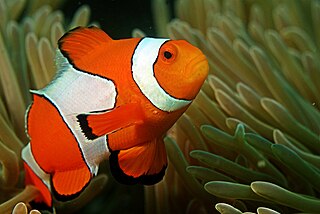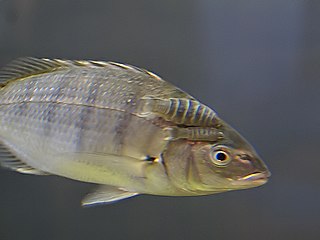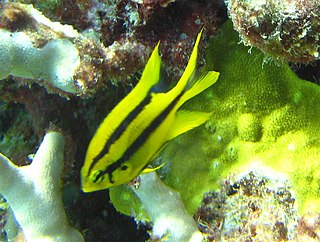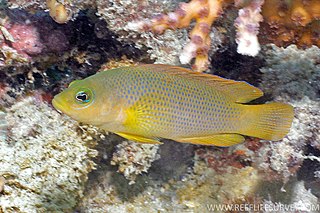
Clownfish or anemonefish are fishes from the subfamily Amphiprioninae in the family Pomacentridae. Thirty species are recognized: one in the genus Premnas, while the remaining are in the genus Amphiprion. In the wild, they all form symbiotic mutualisms with sea anemones. Depending on species, anemonefish are overall yellow, orange, or a reddish or blackish color, and many show white bars or patches. The largest can reach a length of 17 cm (6.7 in), while the smallest barely achieve 7–8 cm (2.8–3.1 in).

Pomacentridae is a family of ray-finned fish, comprising the damselfishes and clownfishes. This family were formerly placed in the order Perciformes but are now regarded as being incertae sedis in the subseries Ovalentaria in the clade Percomorpha. They are primarily marine, while a few species inhabit freshwater and brackish environments. They are noted for their hardy constitutions and territoriality. Many are brightly colored, so they are popular in aquaria.

Cymothoa exigua, or the tongue-eating louse, is a parasitic isopod of the family Cymothoidae. It enters fish through the gills and the female attaches to the tongue, with the male attaching on the gill arches beneath and behind the female. Females are 8–29 millimetres (0.3–1.1 in) long and 4–14 mm (0.16–0.55 in) wide. Males are approximately 7.5–15 mm (0.3–0.6 in) long and 3–7 mm (0.12–0.28 in) wide. The parasite severs the blood vessels in the fish's tongue, causing the tongue to fall off. It then attaches itself to the remaining stub of the tongue and becomes the fish's new tongue.

Fire corals (Millepora) are a genus of colonial marine organisms that exhibit physical characteristics similar to that of coral. The name coral is somewhat misleading, as fire corals are not true corals but are instead more closely related to Hydra and other hydrozoans, making them hydrocorals. They make up the only genus in the monotypic family Milleporidae.

Chromis viridis is a species of damselfish. Individuals tend to be iridescent apple-green and light blue, and reach a maximal length of 10 cm.

The ring-tailed cardinalfish is a widespread fish species in the family Apogonidae found in the Red Sea and off East Africa to Papua New Guinea, north to Japan, and south to Australia.

Acanthurus coeruleus is a surgeonfish found commonly in the Atlantic Ocean. It can grow up to 39 centimetres (15 in) long. Common names include Atlantic blue tang, blue barber, blue doctor, blue doctorfish, blue tang, blue tang surgeonfish, yellow barber, and yellow doctorfish.

The leopard coral grouper, also known as the common coral trout, leopard coral trout, blue-dotted coral grouper or spotted coral grouper, is a species of marine ray-finned fish, a grouper from the subfamily Epinephelinae which is part of the family Serranidae, which also includes the anthias and sea basses. It is found in the Western Pacific Ocean.

The Cymothoidae are a family of isopods in the suborder Cymothoida and are found in both marine and freshwater environments. Cymoithoids are ectoparasites, usually of fish, and among their number they include the bizarre "tongue-biter" which attaches to a fish's tongue causing it to atrophy, and replaces the tongue with its own body. Ceratothoa oestroides is one of the most devastating ectoparasites in Mediterranean aquaculture. Around 40 genera and more than 380 species of cymothoid are recognised. Species of the Cymothoidae are generally found in warmer waters and rarely in the cool and cold climates.

Chromis chromis, the damselfish or Mediterranean chromis is a small species of ray-finned fish of the family Pomacentridae from the Eastern Atlantic and Mediterranean.

Neoglyphidodon nigroris, common name black-and-gold chromis or Behn's damsel is a damselfish from the Indo-West Pacific. It occasionally makes its way into the aquarium trade. It grows to a size of 13 centimetres (5.1 in) in total length.

Acanthochromis polyacanthus, the spiny chromis damselfish, is a species of damselfish from the western Pacific. It is the only member of its genus.

The yellowtail damselfish is a species of damselfish native to tropical areas such as the Caribbean coast of Panama. Damselfish are abundant in coral reef environments. The International Union for Conservation of Nature lists this fish as being of “least concern”. The species is exploited on a minor scale, for fisheries and the aquarium trade. It may be threatened by the invasive lionfish.

Pseudochromis fuscus is a species of saltwater fish in the dottyback family. Dottybacks are generally very bright in color and relatively small, factors which have made them popular among aquarium enthusiasts. Besides their coloration and size, they are probably best known for their aggressive temperament. While many of the more common dottybacks are in the Pseudochromis genus, there are also species in other genera. Common names for this particular species include the brown dottyback, the golden dottyback, and the musky dottyback. The common name “Golden dottyback” is shared with another species of dottyback, the Pseudochromis pseudoplesiopinae. The species name, fuscus, means dark or dusky in Latin.

Like humans and other animals, fish suffer from diseases and parasites. Fish defences against disease are specific and non-specific. Non-specific defences include skin and scales, as well as the mucus layer secreted by the epidermis that traps microorganisms and inhibits their growth. If pathogens breach these defences, fish can develop inflammatory responses that increase the flow of blood to infected areas and deliver white blood cells that attempt to destroy the pathogens.

Coral reef fish are fish which live amongst or in close relation to coral reefs. Coral reefs form complex ecosystems with tremendous biodiversity. Among the myriad inhabitants, the fish stand out as colourful and interesting to watch. Hundreds of species can exist in a small area of a healthy reef, many of them hidden or well camouflaged. Reef fish have developed many ingenious specialisations adapted to survival on the reefs.
Cymothoa elegans is a species of parasitic isopod in the genus Cymothoa. It has rarely been recorded, with all records coming from the north coast of Java. They are in the arthropod phylum and can more closely be classified as crustaceans.

The Barrier Reef chromis, also known as the yellowback puller or shining puller, is a species of damselfish in the family Pomacentridae native to the east coast of Australia. It is a small fish with a yellowish-brown dorsal surface separated by a dark stripe from its silvery flanks and underside.

Anilocra capensis is a species of parasitic isopod in the family Cymothoidae. It is endemic to southern Africa. The species preferentially attaches itself to the hottentot.

C. oestroides is a crustacean isopod, obligate ectoparasite of marine fish that dwells in the buccal cavity. It is the causative agent of various pathologies including tissue damage at the parasitisation site (tongue), growth defects, decrease in mean host weight and size and increases mortalities in farmed and wild fish populations. It has been recorded in six different fish families: Sparidae, Carangidae, Clupeidae, Maenidae, Scorpenidae, and Mugilidae.



















